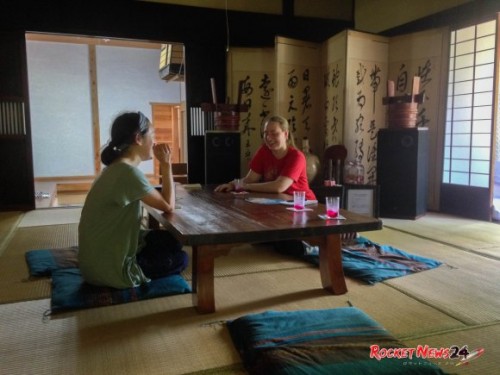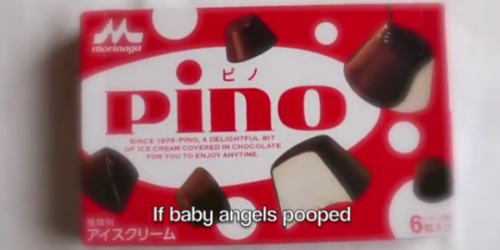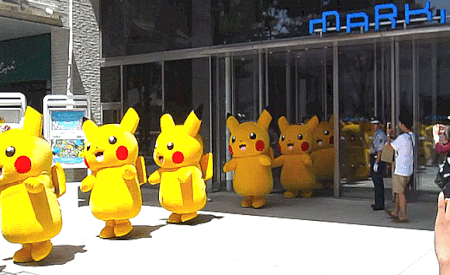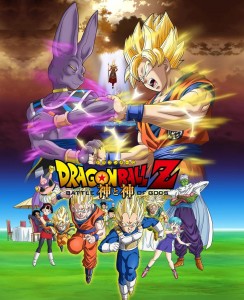Justin’s Japan: Interview with James Rolfe of Cinemassacre on ‘Angry Video Game Nerd: The Movie’
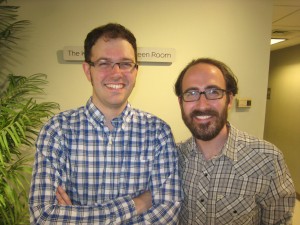
James Rolfe, left, on the Angry Video Game Nerd movie with co-writer/co-director Kevin Finn: “To me, it’s the ultimate fan-film. It’s made by fans, for fans. It means dreams can come true, with a lot of hard work and personal sacrifice.” (Justin Tedaldi)
By JQ magazine editor Justin Tedaldi (CIR Kobe-shi, 2001-02) for Examiner.com. Visit his Japanese culture page here for related stories.
An Internet sensation that debuted as the Angry Video Game Nerd ten years ago, filmmaker James Rolfe has taken millions of YouTube visitors back to the past with his hotheaded, foulmouthed alter ego, who gleefully tears down some of the most notorious titles and accessories (the Power Glove, anyone?) from the golden age of retrogaming. (If you’ve ever thrown a controller across the room, you’ll understand.)
As the creative linchpin of his website and production company Cinemassacre, the AVGN legend culminates with this year’s release of Angry Video Game Nerd: The Movie, a feature-length, years-in-the-making collaborative effort between Rolfe and co-writer/co-director Kevin Finn. A satisfyingly silly sci-fi/adventure hybrid in the Troma tradition, the film enjoyed a sold out 16-city North American screening tour earlier this summer, and makes its Vimeo on Demand debut today (Sept. 2), with a DVD/Blu-ray release planned for the holiday season.
In this exclusive, wide-ranging interview, I spoke with Rolfe about everything from the film’s New York premiere last month, the Nerd Renaissance we’re currently living in, and the most “Japanese” (i.e., insane) game he’s ever played.
It feels like we’re living in some kind of Nerd Renaissance—even “Weird Al” Yankovic’s last album went to number one. How do you feel about all this?
Nerds were big in the ’80s. It’s all coming back now. I feel there’s a much broader definition of “nerd” now, and it’s something to be proud of.
What are your thoughts on the live appearances you’ve had promoting the film so far? Which moments have been the most memorable?
Since July 21, we’ve been touring this movie around, city by city. It’s been amazing. The energy from the crowd is fantastic! There’s nothing like watching the movie with live reactions. The best moment is during the opening credits. Everyone cheers. Sometimes they clap along with the music. You can really feel the hype building up to the AVGN title screen. Then it explodes, and everyone goes nuts.
What can you share about the back-to-back screenings held for the New York premiere?
It was a rowdy crowd. Especially the second screening. I loved it, though it was exhausting. Under normal circumstances, I would be sick of looking at this movie, but the fans make it exciting every time. It never gets old.
Mount Fuji and Godzilla movies play a prominent role in the film. If you were to ever visit Japan, what would you most want to see and do there?
I’ve always wanted to go. There isn’t one thing in particular. I’d just like to see all around the major cities like Tokyo. Just normal tourist things.
What are some of your favorite moments of “Japaneseness” in video games that you’d like to give a shout-out to?
Hmmm. Not sure. Probably Ninja Baseball Bat Man! That game is insane.
For the complete story, click here.
Justin’s Japan: Nippon in New York — J-COLLABO Fall Fest, Craft Beer, The Joy of Sake, Akiko Yano
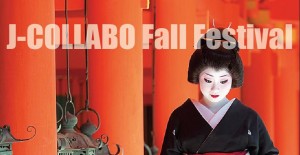
Osaka-based Geisha Kikuno comes to J-LABO Brooklyn for two performances with multimedia director Kenji Williams Sept. 7. (Courtesy of J-COLLABO)
By JQ magazine editor Justin Tedaldi (CIR Kobe-shi, 2001-02) for Examiner.com. Visit his Japanese culture page here for related stories.
As the summer winds fade into fall colors, the weeks ahead are shaping up with these exciting events, ready to be enjoyed after Labor Day.
Sunday, Sept. 7, 1:00 p.m.
J-COLLABO Fall Festival feat. Geisha Kikuno
J-LABO Brooklyn, 300 Seventh Street
Suggested donation: $20
The history of the geisha spans over 300 years. Their beauty and grace is legendary as is their exceptional skill in music, dance and entertainment. In spite of a near worldwide fascination, the number of geisha is decreasing year by year. Geisha Kikuno is a unique Geisha from Osaka. She is dedicated to finding new approaches to promote this unique history to the next generation, and will come to New York for two performances to demonstrate this ancient art form in collaboration with multimedia director Kenji Williams.
Friday, Sept. 12, 6:30 p.m.
Kampai! The World of Japanese Beer
Japan Society, 333 East 47th Street
$28, $23 Japan Society members/seniors
Pull up a stool to Japan Society’s annual beer lecture and tasting, featuring unique and rare brews from Japan’s emerging craft beer industry. Mark Meli, professor at Kansai University and author of Craft Beer in Japan: The Essential Guide, delves into the culture, history and innovative brews coming out of Japan’s beer scene during the lecture. At the tasting reception, enjoy the opportunity to sample many unique and hard-to-come-by brews. Must be at least 21 years old.
Sept. 12-Oct. 10
Japan — An Island Nation: 1870-1890
Resobox Gallery, 41-26 27th Street, Long Island City
Free
An exhibition of entrepreneurial class culture from the Burns Archive. Japan — An Island Nation showcase the best of Japanese photographs that were made to show the perceived exotic nature of Japan to the West. Photographers, under government supervision, documented the artisans, shopkeepers and workers that made up the bulk of the Japanese middle and working class entrepreneurial society. It was critical for Japanese “public relations” of the era to put a face on Japan’s people and products, and through international fairs and expositions the world was introduced to Japan. A free opening reception will be held Friday, Sept. 12 from 7:00 p.m.-9:00 p.m.
For the complete story, click here.
JQ Magazine: JQ&A with John Gaunter on ‘Sake Confidential’
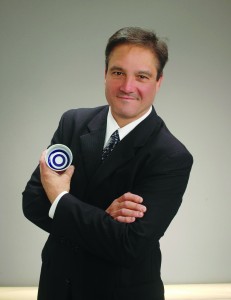
“Sake is so deep and varied that one could never stop talking about it. Every day is full of surprises. Not major ones, but usually surprises related to the attention to detail that goes into sake and the interesting stories behind it.” (Courtesy of John Gauntner)
By Eden Law (Fukushima-ken, 2010-11) for JQ magazine. Eden is a JETAA New South Wales committee member, who would like it to be known that if it wasn’t for getting involved with JETAA, he wouldn’t know what to do with his spare time after hours. JET: It’s like the Illuminati, except less about the world domination and more about the fun denomination. Got feedback on this article? Leave a comment below.
If ever there was a prize for most unexpected job opportunity spin-off from the JET Program, the career of John Gauntner (Kanagawa-ken, 1988-89) would be hard to beat, especially after a few rounds of nihonshu. A longtime resident of Kamakura and the world’s first (and only) non-Japanese to hold certification as both a Master of Sake Tasting and Sake Expert Assessor, Gauntner has come a long way since a drinking session with a buddy from The Japan Times led him to this series of fortunate events.
Proving that this beverage continues to be an infinite font of inspiration, Gauntner has recently added a new book to his growing stable of literary output, Sake Confidential: A Beyond-the-Basics Guide to Understanding, Tasting, Selection, and Enjoyment. In it, he covers all aspects of the precious drop: from what it is, how it is made, and how it is meant to be enjoyed (spoiler: any way you like it), to the inside story of its politics, marketing, and the industry itself. But this is no textbook: Like a true sake evangelist, Gauntner enlightens beginners and insiders alike, pairing clear and simple language with confidence and unabashed passion.
In this exclusive interview, Gauntner discusses the state of sake’s popularity in its own country and abroad, what it means being a non-Japanese sake evangelist with his unique qualifications, and what the future holds for him.
What was the reason behind writing this book, and who is its audience?
I wanted to show the depth and breadth of the sake world, to show it has as many avenues for exploration as wine does.
How is this book different from the others?
This book goes beyond the basics and more into depth about many interesting side topics of the sake world.
Is this book designed to replace or update your previous books?
No, it is intended to augment them. This one introduces less sake and is light on the basics,
What’s the market like for these books?
So far it is selling well, but ask me in two years!
What’s left to be said about sake? Are there any surprises left in the industry?
It is so deep and varied that one could never stop talking about it. Every day is full of surprises. Not major ones, but usually surprises related to the attention to detail that goes into sake and the interesting stories behind it.
【RocketNews24】Hello Kitty isn’t a cat!? We called Sanrio to find out!
Posted by Michelle Lynn Dinh (Shimane-ken, Chibu-mura, 2010–13), editor and writer for RocketNews24. The following article was written by Preston Phro, a writer and translator for RocketNews24, a Japan-based site dedicated to bringing fun and quirky news from Asia to English speaking audiences. 
By now you’ve probably read the earth-shattering, heart-rending news that Hello Kitty’s own copyright holder Sanrio recently alleged that the world’s most famous bow-sporting feline isn’t actually a cat. If, like me, you’re a huge fan of Japan’s unofficial mascot, you probably already started going through the five stages of grief, too.
I, however, never got past denial. Instead, I picked up the phone and called Sanrio’s PR department in Japan. My findings will bring your suffering heart some relief.
Continue reading at RocketNews24!
JQ Magazine: Book Review — ‘Japan 365: A Drawing-A-Day Project’
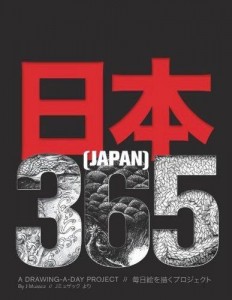
“Using nothing more than the simplest tools at hand to capture the moment, the artist establishes a tangible reality that lends an urgency and authenticity to the work that would not be possible in a more polished and composed form.” (J Muzacz)
By Rafael Villadiego (Nagasaki-ken, 2010-13) for JQ magazine. A member of JETAA New South Wales, Rafael is a collector of words on a journey still searching for a destination, who has a tendency to forget, we are all sometimes like the rain…
“If you attach a reason to an adventure, it ceases to be one.” –Uemura Naomi, noted Japanese mountain climber and adventurer.
「冒険に理由をつけると、冒険でなくなってしまう。」植村直己
There is something timeless and romantic about the idea of the wandering artist. Drifting aimlessly down untrodden roads and stumbling across hidden paths. Going wherever the wind might take them and all the while sketching random scenes from daily life, in all its raw and unfettered glory.
Japan 365: A Drawing-A-Day Project by current Melbourne resident J Muzacz (Kyoto-fu, 2010-12) is a drawing-a-day project that sets out to capture this sense of artistic wonder, in a fitting meditation on contemporary Japan. A black-and-white reproduction of sketches produced with nothing more than a simple ballpoint pen and notebook, the project sets aside all pretension and gaudy artifice and pares everything down to its barest essentials and fundamental simplicity. It is especially gratifying to see some pieces scribbled on the back of old pieces of paper or second-hand timetables. Using nothing more than the simplest tools at hand to capture the moment, the artist establishes a tangible reality that lends an urgency and authenticity to the work that would not be possible in a more polished and composed form.
While by no means an artist myself, there is something to be said about living the dream: An errant dreamer recording the world as they see it unfold. However, such whimsical fancy fails to fully appreciate the hard work and dedication inherent to such an undertaking. Consciously choosing to actively produce a completed work of art, every single day, for a solid year, is no mean feat. Having it ultimately culminate into such a hefty tome worthy of sitting comfortably on any coffee table or bookshelf, and feeling the solid weight of it all in your hands, is nothing short of remarkable. Artist/writer Muzacz and his supporters must be heartily commended for seeing it to fruition.
【Exploring Unfamiliar Japan】We stayed in a 120-year-old Japanese home, here’s how you can too
Michelle Lynn Dinh (Shimane-ken, Chibu-mura, 2010–13) is an editor and writer for RocketNews24, a Japan-based site dedicated to bringing fun and quirky news from Asia to English speaking audiences.
When European writer, Lafcadio Hearn, wrote about Shimane prefecture in 1894, he described a land steeped in tradition and nature. Since then, all of Japan seems to have ignored this sleepy area of the Chugoku region whose most recent claim to fame is having the country’s largest population of the elderly. But if Shimane prefecture is stuck in the olden days, the Oki Islands are lost in time. Lazily floating out at sea in what is technically Shimane, but is actually an entire world of its own, Oki is a forgotten gem tucked in a dusty corner of Japan. Rambling down the overgrown back roads, you’re sure to come across a wrinkled face and a hearty “konnichiwa,” a small experience that seems to have become a rarity in the always busy metropolises of this country.
It is in this uncommon place that we had the privilege of staying in a home that has stood for over a century. Join us as we share our experience staying at the Japanese guesthouse called Tsukudaya.
Join us on our island adventure here.
JQ Magazine: JQ&A with Trixie Cordova, Peace Boat US Volunteer Staff and World Up Education Director

Trixie’s advice for new JETs: “Soak it in! Challenge yourself to try new things, explore the country, eat crazy foods, GET NAKED (at an onsen, anyway). Appreciate how different and preserved Japanese culture truly is, and don’t take your time abroad for granted. You were a chosen one, so embrace it!” (Courtesy of Trixie Cordova)
By Mark Flanigan (Nagasaki-ken, 2000-04) for JQ magazine. A member of the JET Alumni Association of New York’s board of directors, Mark is a program director at the Japan ICU Foundation in New York City and was also a Rotary Peace Fellow at ICU from 2010-12, during which time he volunteered for a tsunami relief mission in Ishinomaki after the terrible 3/11 tragedy. He can be contacted at mflanigan[at]jicuf.org.
Trixie Cordova (Shimane-ken, 2007-09) began volunteering with Peace Boat US in New York since last October. A civil society and non-profit organization, Peace Boat US works to promote peace, sustainable development, human rights and respect for the environment throughout the United States and the world through educational programs organized in partnership with the Japanese NGO Peace Boat, which carries out its main activities through a chartered passenger ship that travels the world on peace voyages.
At the same time, Cordova has served as education director for World Up, a non-profit organization based in Brooklyn that uses music, specifically hip-hop, and technology education to explore local and global issues affecting youth today. A graduate from Teachers College at Columbia University with a Master’s in International Educational Development, concentrating on Peace Education, Cordova has been quite active in JETAANY as well, serving on a career panel for recently returned JETs this past year. Prior to living and working in New York, she taught English in rural Japan for two years, where she first learned about Peace Boat while on the JET Program.
As a Peace Boat US volunteer, Cordova has been working toward creating opportunities for New York youth to participate in the Music and Art Peace Academy (MAPA) Program on board the ship. This summer, she will work closely with Unique Waters of World Up’s after-school music program “WU School” at the Brooklyn Community Arts and Media High School. Together they will lead music and leadership-based activities to promote cross-cultural understanding and to collaborate on a musical soundtrack to MAPA this summer.
JQ reached out to Cordova recently to ask her more about how her experiences in Japan and the Peace Boat-JET connection has led to this sea change in global education.
Thanks for taking the time to share your story, Trixie! Where and when were you placed on JET? Was it your first time in Japan?
Sure thing! I was an elementary and JHS ALT in Gotsu, Shimane, from 2007-09. Shimane’s claim to fame is that it isn’t famous—check out their unofficial mascot, Yoshida-kun, as proof! It was definitely my first time to Japan—I never studied the language or the culture before setting foot in Tokyo for JET orientation.
What was perhaps the biggest misconception you had about Japan before your experience on JET?
I honestly didn’t have very many preconceived notions about Japan, especially given that my decision to do JET was primarily just focused on moving abroad ANYWHERE, not necessarily because of any romanticized ideas I had about Japanese culture. Having said that, I think the biggest misconception I had about Japan was probably that the entire country had access to high-end technology and modern homes. I quickly realized that while that might be true in places like Tokyo, that was definitely not the case in rural Japan.
How many other JETs were in your town or local area?
In Gotsu, there were three ALTs—two JHS’s (dividing up the 10 elementary schools and four JHS), and one HS. I believe there was also a CIR, but ours was from China, and never really participated in JET-related events from what I can recall.
Gotsu was about 20-25 minutes from Hamada, where even more JETs lived! So we’d often go to visit Hamada, especially for sushi Thursdays at Sushizou!
【RocketNews24】5 awesome Japanese ice creams that are perfect for summer
Posted by Michelle Lynn Dinh (Shimane-ken, Chibu-mura, 2010–13), editor and writer for RocketNews24. The following article was written by Philip Kendall (Fukushima-ken, Shirakawa-shi, 2006–11), senior editor and writer for RocketNews24, a Japan-based site dedicated to bringing fun and quirky news from Asia to English speaking audiences.
It’s the middle of August, and while the days we’ve been having recently aren’t quite as face-meltingly hot as those a couple of weeks ago, it is nevertheless still pretty toasty out there. Thankfully, just like when suffering with a cold or sore throat, the summer heat does afford us one very tasty luxury: a genuine excuse to gorge on delicious ice cream!
If you’re feeling the heat this summer, or are just curious about some of Japan’s go-to ice cream treats, join us after the jump for a special video featuring five of our frozen favourites.
You can pick up the five ice creams featured in our video from pretty much any supermarket or convenience store in Japan, so you’re never too far away from epic refreshment and creamy luxury. We must warn you, though: watching this video may cause uncontrollable salivation and pangs of jealousy in those living outside Japan.
This is of course just the tip of the vanilla-flavoured iceberg – there are tons more ice cream treats out there to try, so be sure to share your own favourites in either the comments section below or over on our YouTube channel. Happy gorging!
【RocketNews24】Pics of Pikachu packs from a day of Pokémon hunting in Yokohama
Posted by Michelle Lynn Dinh (Shimane-ken, Chibu-mura, 2010–13), editor and writer for RocketNews24. The following article was written by Casey Baseel, a writer and translator for RocketNews24, a Japan-based site dedicated to bringing fun and quirky news from Asia to English speaking audiences.
A few weeks ago, the handlers of the Pokémon franchise announced the Pikachu Tairyou Hassei Chu, or “An Outbreak of Pikachus” event. First they brightened our day with a TV ad showing the adorable Pocket Monsters hanging out in a shopping mall. Then they teased us with a photo of the electrified rodents landing on the dock.
And now, they’re here!
We grabbed our cameras and went Pikachu hunting in Yokohama, and we were not disappointed. We were, though, almost completely paralyzed by the awesome overdose of cuteness that comes from a parade of a pack of 20 Pikachus.
Check out all the cute Pikachu action in videos and pictures here!
JQ Magazine: Book Review — ‘Year Zero: A History of 1945’
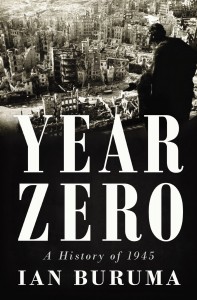
“Though so many of the complexities of World War II and ensuing changes can not easily be summarized, Buruma’s analysis of 1945 provides several enlightening answers that begin to answer the question of how and to what degree a sense of normalcy is achieved after destruction.” (Penguin Press)
By Sheila Burt (Toyama-ken, 2010-12) for JQ magazine. Sheila is a scientific writer at the Center for Bionic Medicine at the Rehabilitation Institute of Chicago. Read more of her writing at her blog.
Consider the following historic events: the bombings of Dresden begin; Franklin D. Roosevelt dies after serving 12 years as president; the B-29 bomber Enola Gay drops “Little Boy” on Hiroshima followed days later by “Fat Man” on Nagasaki, resulting in hundreds of thousands of deaths, unprecedented instant destruction, and long-lasting illnesses caused by radiation exposure; after six long, bloody years, the Second World War finally ends.
Now consider that all of these events took place in 1945.
Following these milestones in the span of only a few months, how could countries so deeply entrenched in World War II return to any sense of normalcy? How do you rebuild a broken nation?
Author and journalist Ian Buruma explores these questions and postwar disorder in his latest book, Year Zero: A History of 1945.
Writing about a single year (or several months within a single year) is not new—among a few other examples, Bill Bryson recently covered the summer of 1927 in One Summer: America, 1927; in 2010; cultural critic Fred Kaplan analyzed the significance of 1959 in his book 1959: The Year Everything Changed; and in 2005, Mark Kurlansky declared 1968 as The Year that Rocked the World.
For Buruma, a Luce Professor of Democracy, Human Rights and Journalism at Bard College and the author of several books, including the novel The China Lover, 1945 may not be more significant than other years but one of the most groundbreaking for transformations. Rather than focusing on the postwar efforts of a single country, Buruma looks at the countries destroyed or nearly destroyed by the ferocity of World War II, specifically narrowing in on the postwar chaos and change in Europe and Japan. “How did the world emerge from the wreckage? What happens when millions are starving, or bent on bloody revenge?” he asks in the prologue.
Justin’s Japan: Nippon in New York – ‘Dragon Ball Z,’ ‘Naruto,’ ‘Angry Video Game Nerd’ premieres
By JQ magazine editor Justin Tedaldi (CIR Kobe-shi, 2001-02) for Examiner.com. Visit his Japanese culture page here for related stories.
In the dog days of summer, it’s best to escape the heat in a place that’s cozy and cool. For those into Japanese cultural events, this month offers a diverse selection of film premieres and live music—all in the comfort of indoor air conditioning.
Aug. 5, 9 and 11
Village East Cinema, 181-189 Second Avenue
$14
Stunning animation and epic new villains highlight the first new Dragon Ball Z feature film in seventeen years! After the defeat of Majin Buu, a new power awakens and threatens humanity. Beerus, an ancient and powerful God of Destruction, searches for Goku after hearing rumors of the Saiyan warrior who defeated Frieza. Realizing the threat Beerus poses to their home planet, the Z-fighters must find a way to stop him before it’s too late. An original work from Dragon Ball series creator Akira Toriyama, Battle of Gods is an exciting new adventure for DBZ fans everywhere. Presented in English. Additional screenings will be held on Aug. 5 at AMC Empire 25 and Regal Union Square Stadium 14. Click here for tickets.
Friday, Aug. 8, 3:30 p.m. and 7:30 p.m.
Angry Video Game Nerd: The Movie
Symphony Space, 2537 Broadway
$20
NYC premiere! Based on the hit web series of the same name, the newly released adventure-comedy, Angry Video Game Nerd: The Movie, follows a disgruntled gamer who must overcome his fear of the worst video game of all time in order to save his fans. Hilarity ensues as a simple road trip becomes an extravagant pursuit of the unexpected. Starring James Rolfe. Written and Directed by James Rolfe and Kevin Finn. A Q&A follows the screening with James Rolfe and Special Guests.
James Rolfe and Kevin Finn’s debut feature film, Angry Video Game Nerd: The Movie, follows a disgruntled gamer (Rolfe) who must overcome his fear of the worst video game of all time in order to save his fans. Desperate to disprove a video game urban legend, hilarity ensues as a simple road trip becomes an extravagant pursuit of the unexpected – and the unexpected ultimately proves that what’s in front of you, isn’t always what it appears to be. Blending elements of comedy, science fiction, and horror, Angry Video Game Nerd: The Movie, is an existential journey which, in the end, discovers truth can be found in the most unlikely of places – and one’s greatest weakness is not the hate one has for a game, but the devotion one has in the face of adversity.
Friday, Aug. 8, 6:00 p.m.
Peace Concert “Global Harmony” with Shinji Harada
West Park Presbyterian Church, 165 West 86th Street
$15 suggested donation
Shinji Harada is one of Japan’s most famous recording artists. He has released more than 70 singles in Japan, three of which once hit the top 20 Oricon chart simultaneously. Born in Hiroshima, Shinji was recently recognized by his home town as a Hiroshima Peace Culture Ambassador.
Shinji became a musical sensation in Japan when he released his debut single Teens’ Blues in 1977 when he was just 18 years old. He released two more singles, Candy in November and Shadow Boxer in December the same year. All three singles ranked in the Top 20 Oricon chart simultaneously, which had never happened before in Japanese music history. Through his music Shinji actively works to spread his brief in “Yamato,” the spirit of sharing kindness and loving one another. He will be joined by percussionist Mataro Misawa and bassist Wornell Jones.
Misawa is a member of Masaharu Fukuyama’s band which recently completed the “Human” tour attended by about half a million people in Japan, Taiwan and Hong Kong. ‘Human”, the album, topped the Oricon rock album chart at #1 after it’s release this spring. Mataro has also performed with many other leading Japanese musicians and groups including Southern All Stars and Masashi Sada. Jones, who is based in Tokyo, has performed with Sly and the Family Stone, Koko Taylor, as well as Chage and Aska, Hiromi Go and many other well-known Jazz and popular musicians in the US and Japan.
This is a rare chance to see some of Japan’s most famous musicians perform in NY! (Your donation will support the annual NY Hiroshima-Nagasaki peace memorial gathering.) For more information, call 646-797-7982 or email: tknakagaki[at]gmail.com.
For the complete story, click here.
JQ Magazine: Manga Review — ‘Showa 1939-1944: A History of Japan’
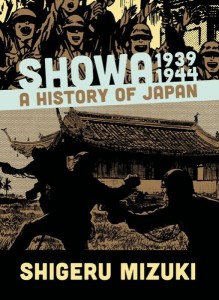
“Showa is an enjoyable book to read, and this volume in particular will appeal to those interested in World War II and comprehensible narratives of the political and military intrigue of the time.” (Drawn and Quarterly)
By Julio Perez Jr. (Kyoto-shi, 2011-13) for JQ magazine. A bibliophile, writer, translator, and graduate from Columbia University, Julio is currently working at Ishikawa Prefecture’s New York office while seeking opportunities with publications in New York. Follow his enthusiasm for Japan, literature, and board gaming on his blog and Twitter @brittlejules.
School might be out, but that doesn’t mean your educational summer reading can’t be fun. Welcome to part two of Shigeru Mizuki’s manga history of Japan during the Showa period! If you’re just tuning in or need a refresher, check out JQ’s review of the first book, Showa 1926-1939: A History of Japan. This series is translated beautifully in English by none other than JET alum Zack Davisson (Nara-ken, 2001-04; Osaka-shi, 2004-06) and published in North America by Drawn and Quarterly.
Illustrious manga artist Mizuki continues his retelling of the Showa period through his mouthpiece character Nezumi-Otoko (sometimes translated as Rat Man) of GeGeGe no Kitaro fame, and in this section includes events you have no doubt heard of such as the attack on Pearl Harbor and the Battle of Midway as well as ones you probably have not such as the Japanese campaign in the Dutch East Indies and the Battle of the Coral Sea, the first true incident of carrier warfare and air-to-air combat.
Mizuki also inserts his own autobiographical story into narrative, providing both a macro historical view and micro personal view of the war. As established in the previous volume, he has portrayed himself in a pretty poor light from the get-go, a good for nothing son that is too lazy to hold a job, can’t properly attend any school, and only seems to have a strong interest in eating as much food as possible. But the humble and comical portrayal of himself should be taken with a grain of salt, as Mizuki points out himself, in this era, “If we had a little food in our bellies, it was considered a blessing….We didn’t think about the future because we didn’t have one. Hard times at home were just the tip of the iceberg. After that there was the army, where all your future holds is an unmarked grave on a godforsaken island.”
JQ Magazine: JQ&A with Harry Hill, Chairman of CULCON
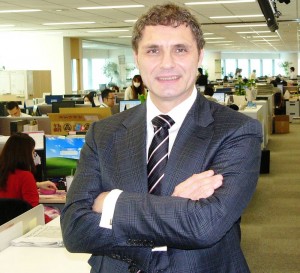
“My advice to the JETs is, don’t be afraid to take center stage and be memorable (of course in a respectful way), because these seemingly random relationships or encounters can be the source of great opportunity.” (Courtesy of Culcon.jusfc.gov)
By Alexis Agliano Sanborn (Shimane-ken, 2009-11) for JQ magazine. Alexis is a graduate of Harvard University’s Regional Studies—East Asia (RSEA) program, and currently works as an executive assistant at Asia Society in New York City.
As a martial artist, Monbusho Fellow, JET, consultant and CEO, there seems little that Harry Hill (Gifu-ken CIR, 1987-88) has not done or experienced when it comes to U.S.-Japan relations.
Now, Hill can add another feather to his cap: last February, the Japan-U.S. Friendship Commission and CULCON (the Conference on Cultural and Educational Interchange) in Washington, D.C. appointed him has their new chairman. For those familiar with Hill and his history, this appointment comes as no surprise: Hill knows Japan as intimately as he knows America. He began his career there as a Monbusho English Fellow in the mid-’80s and then served as a JET in Gifu Prefecture, experiences that helped him to tap into hitherto unexplored entrepreneurial sectors, in particular sports-related infomercials.
Since 2006, his company, Oak Lawn Marketing has been the largest infomercial brand in Japan. If you’ve seen Billy’s Bootcamp advertised there, you have Hill to thank for. Now back stateside, Hill uses his broad background in education, culture, business and non-profits to further strengthen interpersonal understanding between the U.S. and Japan. JQ caught up with Hill at his new digs—asking about life, opportunities and the risks that inevitably lead to his success.
Could you explain your background with Japan?
I developed a passion for martial arts, budo, and Shorjinji Kempo, in particular, during my time at college. This passion creates a curiosity and interest in Japan. During the summer of my sophomore year, I spent several weeks imagining my future. One of the books that influenced me at the time was Japan as Number One by Ezra Vogel. Looking around my immediate peers and acquaintances, I knew very few people who knew about Japan or could be considered Japan experts. Yet, many smart and respectable people were stating that Japan and Asia was the next land of opportunity. So I decided to start Japanese language training in my junior year with the intent of finding opportunity in Japan.
How did your time as a Monbusho English Fellow and JET lead to a career as an entrepreneur?
I was an MEF in Gifu Prefecture from 1985-1987 and the first CIR in Gifu during the first year of the JET Program from 1987-1988. As an MEF, I worked at both the kencho and kyoiku center. At the kyoiku center I helped put together teacher training programs for English teachers. In my two years in Gifu, I probably met and helped with training probably almost every junior high school or high school teacher in Gifu. I was also essentially a one-shot teacher. During my two year stint, I visited something like 230 of about 240 junior high schools and high schools, hence my job was more of a cultural ambassador who offered exposure to the English language and U.S. culture.
In 1988, Gifu hosted a regional exposition “Mirahaiku.” Since I also had a desk at the kencho, I was asked by the general affairs division to make the English name for the expo, which I named “Future Watch ’88.” The English name received a significant amount of press coverage, more from local media and to a lesser extent English language media, but inspired the organizers that the expo should have an international flavor. As a CIR from 1987-1988, some of my main responsibilities was to work for the planning organization for the expo, which was a hybrid of individuals seconded from both business and government. The expo was a great success, and the network of business leaders and government leaders with whom I worked side by side gave me the confidence that I could do business and open doors if I started my own business.
Justin’s Japan: ‘Dragon Ball Z,’ ‘Naruto’ Come to the Big Screen
By JQ magazine editor Justin Tedaldi (CIR Kobe-shi, 2001-02) for Shukan NY Seikatsu. Visit his Examiner.com Japanese culture page here for related stories.
This August will be a hot month for anime fans, as the latest feature length entries for two of the world’s most popular series debut at Village East Cinema.
First up (Aug. 5 and 9) is “Dragon Ball Z: Battle of Gods,” the 18th animated feature of author Akira Toriyama’s massively popular martial arts adventure series “Dragon Ball,” which celebrates its 30th anniversary this year. The plot focuses on the dessert-loving God of Destruction Beerus, who awakes from a decades-long slumber to challenge Goku, the strongest fighter in the universe.
“‘Dragon Ball Z’ has been a gateway for me personally. Growing up watching Toonami in the ’90s, the series influenced me as a kid to become obsessed with Japanese animation,” said Maj Mack, founder and CEO of GoBoiano, a fast-growing anime startup with over 300,000 social media followers worldwide.
Another long-running series (fifteen years and counting), “Naruto,” premieres Aug. 31-Sept. 1 with its ninth feature film, “Road to Ninja: Naruto the Movie.” Set in an alternate timeline in which its characters have different origin stories and personalities, and featuring the theme song “Sore de wa, Mata Ashita” by the J-rock band Asian Kung-Fu Generation, “Road to Ninja” became the highest grossing “Naruto” movie to date within two months of its release in Japan.
For tickets, visit www.fandango.com.
JQ Magazine: Book Review — ‘A True Novel’
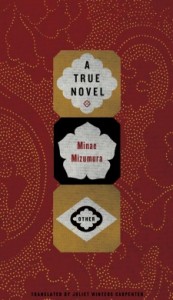
“A True Novel remarkably depicts the sense of isolation that anyone who has lived abroad or moved to a new place experiences. It captures the very human and conflicted desires to simultaneously fit into a society while also desiring to rebel against its impositions.” (Other Press)
By Julio Perez Jr. (Kyoto-shi, 2011-13) for JQ magazine. A bibliophile, writer, translator, and graduate from Columbia University, Julio is currently working at Ishikawa Prefecture’s New York office while seeking opportunities with publications in New York. Follow his enthusiasm for Japan, literature, and board gaming on his blog and Twitter @brittlejules.
This is the story of a poor boy that had the misfortune to fall in love with a rich girl. A classic Gothic tale of romance transplanted and re-imagined in postwar Japan. If you like your lovers star-crossed and your antiheroes of the rags to riches variety, then you’re in for a treat with Minae Mizumura’s A True Novel. Winner of the Yomiuri Literature Prize in 2002, A True Novel is a book filled with familiar themes executed in interesting new ways. It is a re-imagining of Emily Brontë’s Wuthering Heights in postwar Japan, with parallels among some characters, but different enough to be original and uniquely Japanese.
A True Novel is a unique and engrossing tale that brings together three seemingly unrelated characters who are united not only by a resigned sense of isolation from their surroundings but also united in their encounters and fascination with the book’s protagonist, Taro Azuma. The focus of the novel is the story of his tragic youth, a poor boy who falls in love with a rich girl, and his growing awareness that he would always be incompatible with her in the eyes of others. He flees to America, where he claws his way up from the dregs of society and overcomes the obstacles of class and wealth to become one of the richest Japanese men of his time. While we learn about his fascinating life through the three different viewpoints of the characters with their sometimes humanly biased perspectives, the book also gives insight into the complex identities of the uprooted lives of immigrants and refugees both in Japan and in America, as well as how attitudes toward them have changed over time. A True Novel remarkably depicts the sense of isolation that anyone who has lived abroad or moved to a new place experiences. It captures the very human and conflicted desires to simultaneously fit into a society while also desiring to rebel against its impositions.
Mizumura has masterfully brought to life narrators and characters from different generations, countries, and social classes, and provides fascinating insight into their lives during different periods of Japanese history. From the bleak years of Imperial Japan’s home front during the Pacific War, and the humbling postwar period, through its modern economic success, and finally to the bubble burst and recent events, Japanese modern history comes alive in an intimate and immediate way that inspires new appreciation and curiosity for the human side of history.


